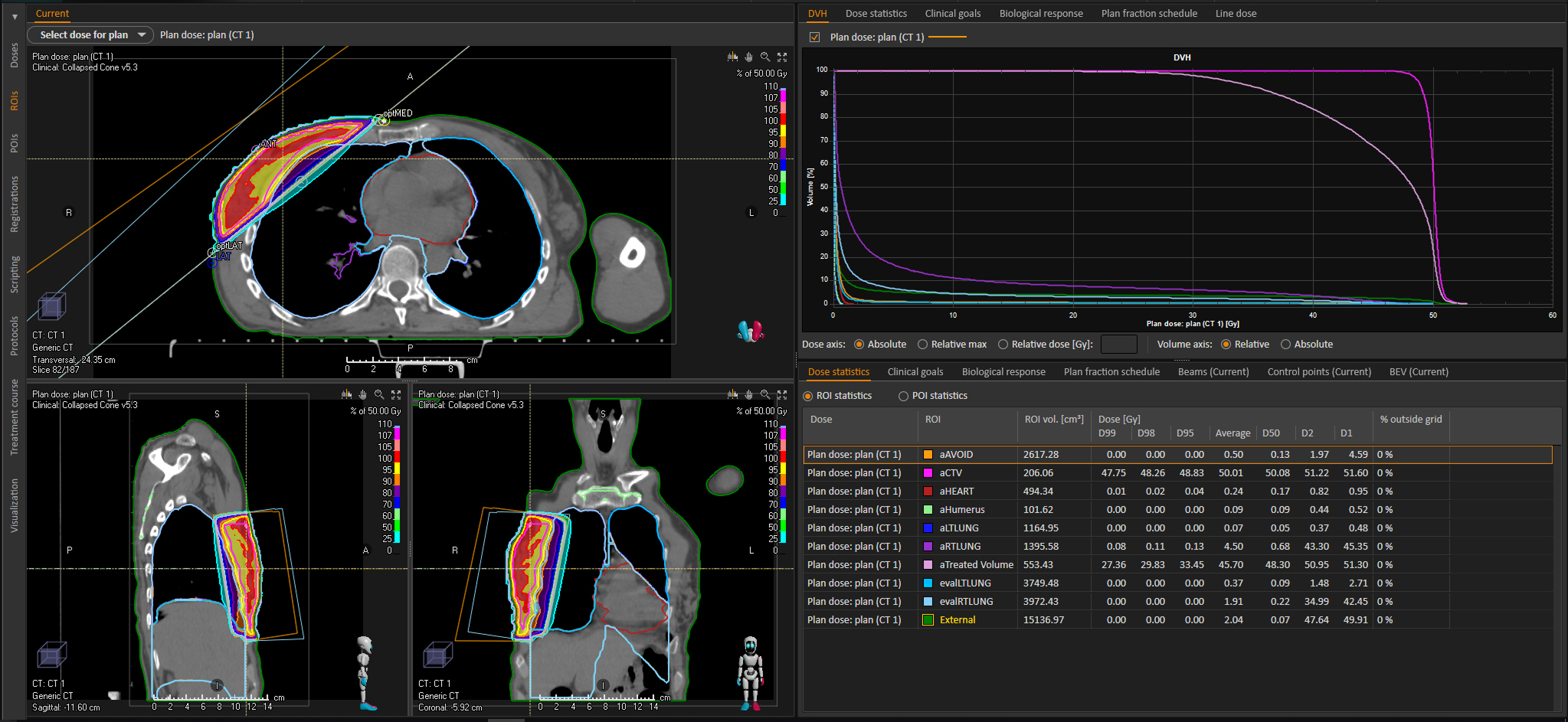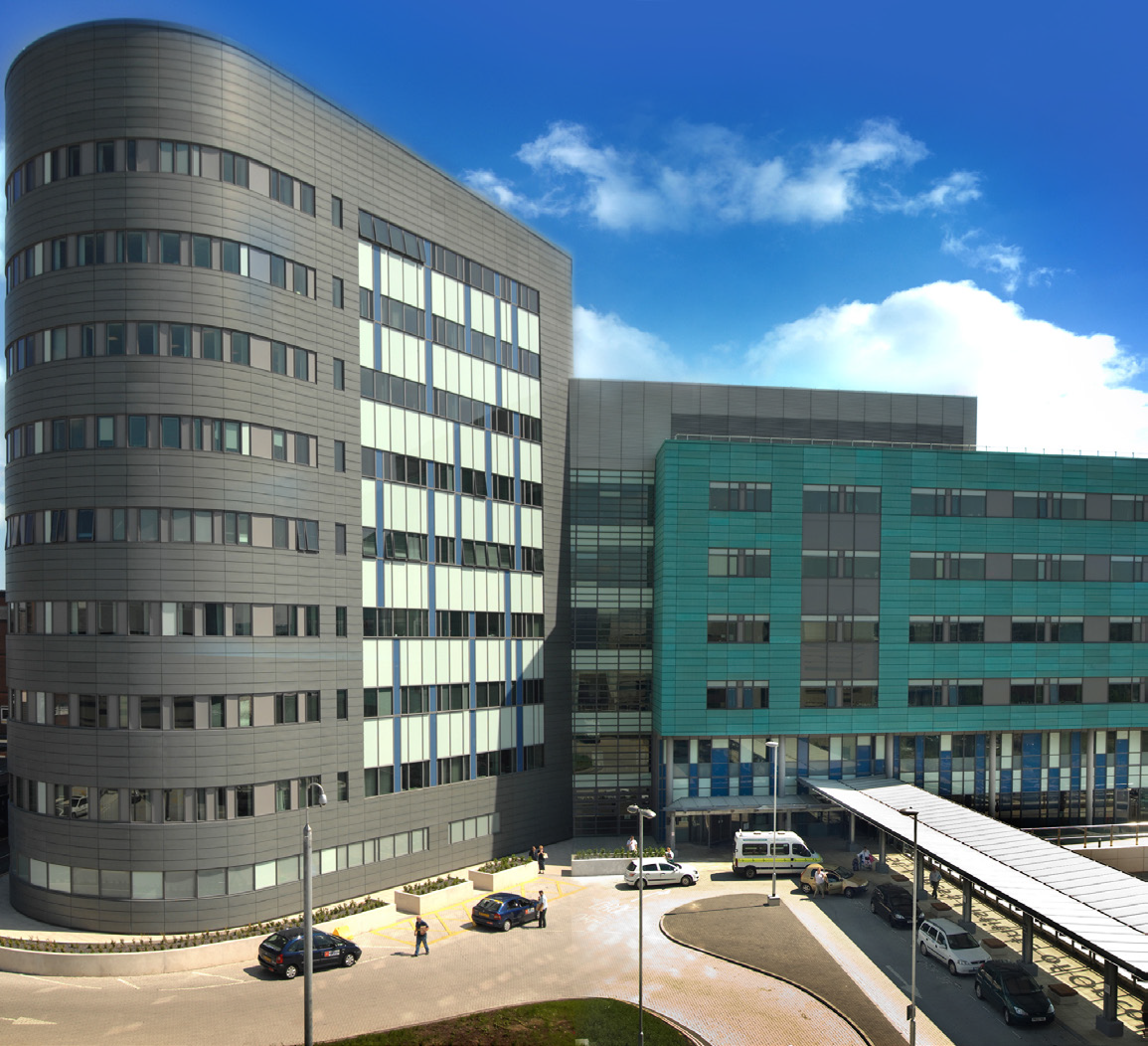We are really pleased with the new planning innovations that RayStation is bringing to our radiotherapy service. Deep-learning auto-contouring is a highly advanced ‘next-step’ that will provide further efficiencies to how we plan breast radiotherapy.”

Case study: LEEDS CANCER CENTRE
DEEP LEARNING SEGMENTATION FOR LUNG DELINEATION DURING BREAST RADIATION THERAPY
UP-TO-DATE TREATMENT, CARE AND SUPPORT
Leeds Cancer Centre opened in 2008 and is part of Leeds Teaching Hospitals NHS Trust, which has more than 18,000 employees. More than 7,500 new patients are treated annually from a catchment population of around 2.8 million people. Specialists at Leeds Cancer Centre diagnose and treat cancer for the people of the city and the nearby Yorkshire region, providing some of the most up-to-date treatment, care and support for cancer patients.
Radiation therapy treatments available include external beam radiotherapy, brachytherapy and gamma knife. A total of ten clinical linear accelerators (linacs) are installed at the center, along with two dedicated research-funded linacs with advanced image-guided radiation therapy capabilities.
A major equipment refresh program will see ten new Elekta Versa HD and three Phillips CT-Sims installed by the end of 2020. The center also uses state-of-the-art imaging, treatment planning and treatment equipment and is committed to refreshing and updating the technology regularly.
*Subject to regulatory clearance in some markets.
ACCURATE CONTOURING
During breast radiation therapy planning, accurate lung contouring is crucial for estimating the organs at risk dose. Previously, automatic lung contours produced by the AutoBreast method in RayStation typically required manual editing to improve accuracy. Clinicians at Leeds Cancer Centre found that RaySearch thorax DL-AC model provides fast and excellent performance for ipsilateral lung contouring in the hypofractionated breast radiation therapy scenario. Given the positive results from RaySearch thorax DL-AC model, radiation oncologists in Leeds are now working closely with RaySearch to develop other machine-learning models for the safe and effective clinical implementation at other treatment sites.
We investigated the geometric and dosimetric accuracy of our new RaySearch thorax deep-learning auto-contouring (DL-AC) solution by comparing them to both reference (manual) contours and contours from the AutoBreast method for a cohort of 10 cancer patients, including left and right sided breast and chest wall treatments. Comparison of the two methods indicated that DL-AC produces accurate contours and V8Gy values, which closely approximate the reference values. AutoBreast generally overpredicts lung volume relative to reference, with less geometric and absolute dosimetric performance. However, for relative DVH statistics, error cancellation renders the overall result close to that obtained with both reference and DL-AC lung contours.
SCRIPT-DRIVEN QUALITY MANAGEMENT WORKFLOW
The team at Leeds Cancer Centre is now developing a script-driven quality management workflow for both DL-AC model training on local data and semi-automated evaluation. This approach will provide clinical confidence in models produced locally from clinical data. Assessment of clinical confidence and utility in RayStation deep learning technologies in Leeds hinges on assessment of the following criteria:
- Geometric accuracy
- Dosimetric impact
- Efficiency
- Independent, automated checking of patient specific DL-AC output
As a result of this comprehensive approach, coupled with the quality of the DL-AC contours produced by the RaySearch model, clinicians in Leeds were able to implement DL-AC derived organs at risk structures for clinical use.
A RETROSPECTIVE STUDY
10 retrospective breast patient plans were used for this analysis. These cases all contained AutoBreast lung contours from planning and had 40Gy in 15 SMLC FFF plans, which was standard practice at Leeds Cancer Centre. Further ipsilateral lung contours were generated by two methods in RayStation. Firstly, the RaySearch thorax DL-AC model was run to produce left and right lung contours. Secondly, reference ipsilateral lung contours were produced by use of the 3D-region growing tool and manual editing.
Threshold values were adjusted to fully contour lung and exclude as much airway as possible. Holes and small contours (<1cc) were removed using the standard tool. Manual editing was performed on a lung window, to exclude diaphragm and airways, and to include any lung not contained in the grown region and correct any other visually detected errors.
Dice similarity coefficient (DSC) was computed for AutoBreast and RaySearch thorax DL-AC lung contours, relative to the reference. DSC was also calculated for the AutoBreast and RaySearch thorax DL-AC model lung intersections with V25% ROI, again with the intersection volume of the manual delineation as reference. Total volumes and V25% overlap volumes were compared for all three sets of lung contours. Absolute (cc) and relative (%) V12.0Gy (30%) statistics were calculated on the 40Gy plan (consistent with V8Gy on a 26Gy plan). Lung contours were visually evaluated by an experienced dosimetrist.
SMALLER MEAN ABSOLUTE ERRORS
On all metrics, the RaySearch thorax DL-AC model showed smaller mean absolute errors relative to the reference, with a smaller range than AutoBreast.
AutoBreast appears to consistently overpredict lung volume, whereas the RaySearch thorax DL-AC model shows a volume difference 95% confidence interval containing zero. DSC is generally high, >0.9, which is expected for large and relatively simple structures such as lung.

RaySearch thorax DL-AC model outperforms AutoBreast on both mean and minimum DSC. Absolute dosimetric errors are smaller with RaySearch thorax DL-AC model, again showing less systematic error than AutoBreast. Relative dosimetric errors are more consistent, although the range of the RaySearch thorax DL-AC model errors is smaller than that for AutoBreast, due to error cancellation when considering relative volumetric parameters.
IMPROVED ADHERENCE OF THE LUNG CONTOUR
Adherence of the lung contour to chest wall is improved using RaySearch thorax DL-AC model, yet small amounts of lung are on occasion excluded at the anterior medial aspect and at the inferior. Airways are correctly excluded as per current contouring guidance. Lung contours appear to be clinically acceptable although manual editing could result in marginal improvements. AutoBreast tends to contour into airways, chest wall and heart. Reference contours can vary between operators but appear broadly similar to those generated by the RaySearch thorax DL-AC model.
HIGHLY ACCURATE METHOD
This analysis and visual inspection suggest that the RaySearch thorax DL-AC model is a highly accurate method for lung delineation in breast radiation therapy. Geometric and dosimetric errors relative to manual lung contouring are small and the mean DSC of 0.97 indicates excellent correspondence with reference contours. The high-dose region, defined as the intersection of lung with the 25% isodose, is also well contoured, resulting in absolute DVH statistics which are very similar to those derived from the reference contours and a significant improvement over those derived from AutoBreast lung contours.
The functionality that is available as standard in RayStation is impressive and we’re sure that it will bring many benefits to planning our patients. We’re confident that the improved functionality and efficiency savings that we’ll be able to make will bring major benefits to the patients that we treat at the Leeds Cancer Centre.”

ADVANCING CANCER TREATMENT
RaySearch is a committed pioneer of oncology software. Since 2000, we have worked in close cooperation with leading centers to improve life and outcomes for patients. We develop all our products from the ground up and continuously revise every aspect, from algorithms to user interface designs. Medical science never stands still, and neither does RaySearch — our relentless drive to do things better leads us to ever-higher performance, accuracy, safety and usability. And this is just the beginning.
We believe software is the driving force for innovation in oncology. Our systems use groundbreaking automation and machine learning to create new possibilities. RayCare*, the next-generation oncology information system, will enable one workflow for all the oncology disciplines, ensuring fluid coordination of tasks and optimal use of resources. RayStation harmonizes treatment planning, providing one point of control for all planning needs — any equipment, any scale.
*Subject to regulatory clearance in some markets.
For more information or to see a demo, contact sales@raysearchlabs.com
